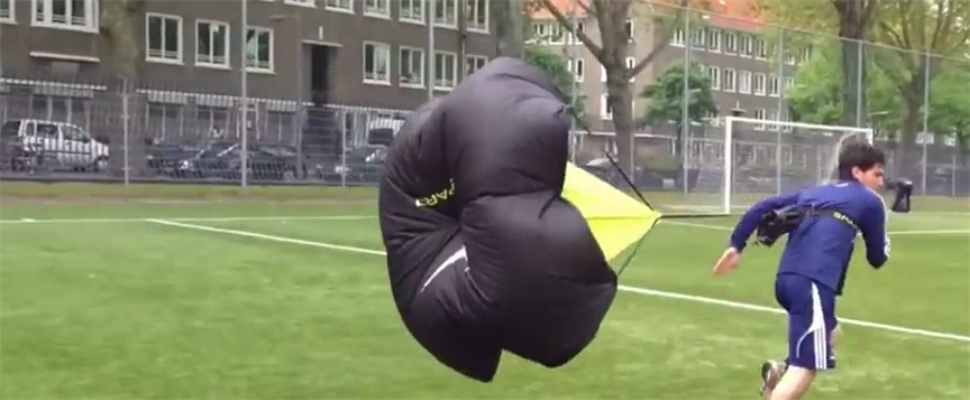SPEED
In-Season Speed Improvement
From Sports Speed-3rd Edition by George Dintiman, Robert Ward
Normal practice sessions during the in-season period in most sports are not long enough to bring about great improvement in most basic training areas. Coaches may also have difficulty finding enough time and deciding where to place the key maintenance programs that will prevent athletes from losing much of their off-season gains. This section provides some guidelines for the proper placement of various training programs and a reasonable time frame that does not significantly detract from the practice schedule and still maintains off-season gains in speed, quickness, strength, power, flexibility, and speed endurance.
Without a well-designed in-season program, it is common in most sports for athletes to lose a percentage of the gains acquired in the off-season. Although additional improvement can occur in an attempt to peak for a specific game or tournament at the latter part of the season, the primary objective of an in-season program is to prevent loss of strength, power, flexibility, speed endurance, speed, and quickness.
Fortunately, there is also a logical order for coaches and athletes to consider. Let’s review this order along with the conditioning and training objectives of each program.
1. General warm-up (jogging, striding, and light sprinting) and dynamic stretching exercises have little conditioning value. Their main contribution is to increase range of motion, help prevent injuries, and warm the body in preparation for the more vigorous aspects of the program. These exercises are completed at the beginning of each workout.
2. Sprint-assisted training is specifically designed to improve stride rate (number of steps per second) and stride length. Because sprint-assisted training requires the complete absence of fatigue, it should be scheduled second in the workout, immediately after the general warm-up and stretching exercises.
3. Scrimmage should follow sprint-assisted training. Keep in mind that the body is still unfatigued, less apt to be injured, and more likely to execute skills at high speed under game conditions.
4. Sport-specific drills for the purpose of skill development are fourth. At this point in the practice session, you are still relatively free from fatigue and can execute at high speed under game conditions. These drills could also precede scrimmage if the emphasis is on mastery of skills rather than conditioning.
5. Calisthenics improve general conditioning, develop strength and muscular endurance, and improve aerobic fitness. They are conditioning-oriented and should not be at the beginning of the workout. After 30 minutes of hard calisthenics, a fresh athlete will turn into a fatigued athlete. Such fatigue will interfere with skill and timing and make you more susceptible to injury.
6. Speed endurance training such as interval sprint training commonly used in football, baseball, basketball, soccer, and other team sports is also a conditioning activity. Because such training brings about a high level of fatigue and makes it difficult to continue a workout much longer, speed endurance training should be near the end of the workout, rather than at the beginning.
7. Ballistics can be incorporated here if practice time allows. Because this is also a conditioning activity, it should occur near the end of the workout.
8. Strength and power training (weight training, plyometrics, and sport loading) is the most fatiguing of any program. It leaves you weak and vulnerable to injury. It is therefore placed close to the end of the workout.
9. A cool-down period is desirable as the last item in a workout and may involve a slow jog or walk and a relaxed static stretching period, particularly after strength and power training.
Under conditioning coach Bob Ward, the Dallas Cowboys used a unique method referred to as speedweek that remains an effective approach during the in-season period for team sports. The program is easy for players to understand and apply and is very effective. Speedweek divides each seven-day period into three phases:
1. Early nonfatigued phase (Monday, Tuesday, Wednesday morning): No leg work (strength and power training or endurance training) is permitted during this period. High-intensity work with sprint-assisted training (tubing, downhill sprinting) dominates this three-day period while athletes are relatively fatigue-free. The proper order described previously is still followed. Upper-body strength and power training takes place.
2. Late fatigued phase (Wednesday afternoon, Thursday, Friday): Training now moves to strength and power training activities (sprint loading, weight training, plyometrics) and speed endurance. During the final four to eight weeks of the preseason period, plyometrics involve only short jumps and hops for 30 to 50 meters at very high speed as opposed to longer jumps at a moderate pace. Sprint-assisted training is not used during this period. Again, the proper order described previously in this chapter is carefully followed.
3. Rest period (Saturday): A light workout is combined with team strategy sessions and one-on-one meetings with specialty coaches.
-
In-Season Speed Improvement
From Sports Speed-3rd Edition by George Dintiman, Robert Ward
Normal practice sessions during the in-season period in most sports are not long enough to bring about great improvement in most basic training areas. Coaches may also have difficulty finding enough time and deciding where to place the key maintenance programs that will prevent athletes from losing much of their off-season gains. This section provides some guidelines for the proper placement of various training programs and a reasonable time frame that does not significantly detract from the practice schedule and still maintains off-season gains in speed, quickness, strength, power, flexibility, and speed endurance.
Without a well-designed in-season program, it is common in most sports for athletes to lose a percentage of the gains acquired in the off-season. Although additional improvement can occur in an attempt to peak for a specific game or tournament at the latter part of the season, the primary objective of an in-season program is to prevent loss of strength, power, flexibility, speed endurance, speed, and quickness.
Fortunately, there is also a logical order for coaches and athletes to consider. Let’s review this order along with the conditioning and training objectives of each program.
1. General warm-up (jogging, striding, and light sprinting) and dynamic stretching exercises have little conditioning value. Their main contribution is to increase range of motion, help prevent injuries, and warm the body in preparation for the more vigorous aspects of the program. These exercises are completed at the beginning of each workout.
2. Sprint-assisted training is specifically designed to improve stride rate (number of steps per second) and stride length. Because sprint-assisted training requires the complete absence of fatigue, it should be scheduled second in the workout, immediately after the general warm-up and stretching exercises.
3. Scrimmage should follow sprint-assisted training. Keep in mind that the body is still unfatigued, less apt to be injured, and more likely to execute skills at high speed under game conditions.
4. Sport-specific drills for the purpose of skill development are fourth. At this point in the practice session, you are still relatively free from fatigue and can execute at high speed under game conditions. These drills could also precede scrimmage if the emphasis is on mastery of skills rather than conditioning.
5. Calisthenics improve general conditioning, develop strength and muscular endurance, and improve aerobic fitness. They are conditioning-oriented and should not be at the beginning of the workout. After 30 minutes of hard calisthenics, a fresh athlete will turn into a fatigued athlete. Such fatigue will interfere with skill and timing and make you more susceptible to injury.
6. Speed endurance training such as interval sprint training commonly used in football, baseball, basketball, soccer, and other team sports is also a conditioning activity. Because such training brings about a high level of fatigue and makes it difficult to continue a workout much longer, speed endurance training should be near the end of the workout, rather than at the beginning.
7. Ballistics can be incorporated here if practice time allows. Because this is also a conditioning activity, it should occur near the end of the workout.
8. Strength and power training (weight training, plyometrics, and sport loading) is the most fatiguing of any program. It leaves you weak and vulnerable to injury. It is therefore placed close to the end of the workout.
9. A cool-down period is desirable as the last item in a workout and may involve a slow jog or walk and a relaxed static stretching period, particularly after strength and power training.
Under conditioning coach Bob Ward, the Dallas Cowboys used a unique method referred to as speedweek that remains an effective approach during the in-season period for team sports. The program is easy for players to understand and apply and is very effective. Speedweek divides each seven-day period into three phases:
1. Early nonfatigued phase (Monday, Tuesday, Wednesday morning): No leg work (strength and power training or endurance training) is permitted during this period. High-intensity work with sprint-assisted training (tubing, downhill sprinting) dominates this three-day period while athletes are relatively fatigue-free. The proper order described previously is still followed. Upper-body strength and power training takes place.
2. Late fatigued phase (Wednesday afternoon, Thursday, Friday): Training now moves to strength and power training activities (sprint loading, weight training, plyometrics) and speed endurance. During the final four to eight weeks of the preseason period, plyometrics involve only short jumps and hops for 30 to 50 meters at very high speed as opposed to longer jumps at a moderate pace. Sprint-assisted training is not used during this period. Again, the proper order described previously in this chapter is carefully followed.
3. Rest period (Saturday): A light workout is combined with team strategy sessions and one-on-one meetings with specialty coaches.
-

Train for Speed
SPEED













